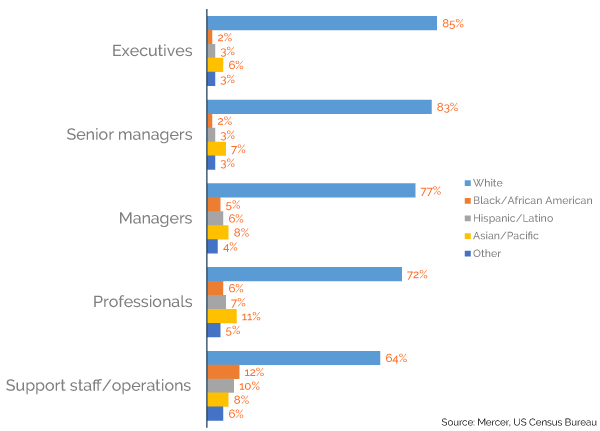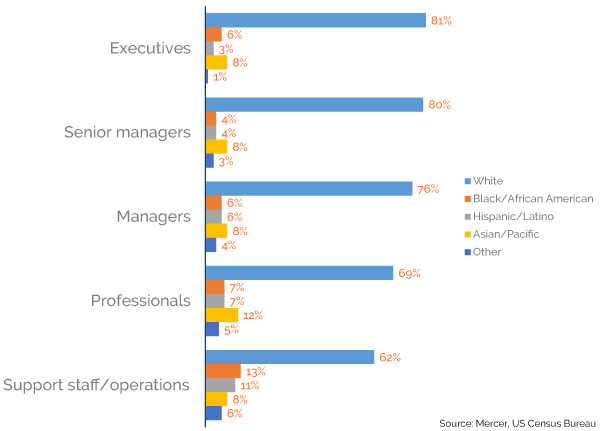CUTTER BUSINESS TECHNOLOGY JOURNAL VOL. 34, NO. 9

As a former technology industry executive and current VP responsible for the development of Black and Latinx technology professionals, Cutter Fellow Robert D. Scott is uniquely positioned to share insights into the hiring, retention, and advancement myths that are pervasive in corporate America. He explains why the needle is not moving, and asks, “What needs to happen to truly make a system change this time, versus the many previous attempts?”
Over the past two years, US technology companies have ramped up their efforts to diversify their workforce. Motivated first by publicity highlighting their low enrollment of people of color and then by explosive examples of social injustice in the news, organizations became “woke” to the need to address the obvious disparities more aggressively in their workforce. Many companies announced major initiatives: donating funds, recommitting to hiring goals, implementing diversity training programs, and so forth. Much was made of these pronouncements. But as the protests subsided, so did the proclamations of change within corporate America.
So, of course, there is skepticism that any of these promises led to tangible outcomes. As Figure 1 illustrates, there are still-underwhelmingly low numbers of people of color, especially at higher career levels.1 Figure 2 shows similarly dismal numbers for women of color.2 Since corporations are not required to disclose statistics on the composition of their workforce, tracking broad progress is difficult at best.

(Adapted from CNBC.)

(Adapted from CNBC.)
Most organizations appear stuck on the “D” part of diversity, equity, and inclusion (DEI). Success is defined by headcount: do I have more (fill in the blank) than I did before. Resources, namely time and money, are invested in recruiting and usually prefaced by the lament that “there are just not enough qualified diverse candidates out there.” This presumption is blatantly false. Qualified candidates with technical education and training are available in ever-increasing numbers. But unconscious bias makes them invisible. Unconscious bias prevents corporations from looking in nontraditional spaces, like historically minority-serving educational institutions or organizations like NPower, a national nonprofit providing free training to military veterans and young adults from underserved communities, preparing them for careers in information technology. Or if found, unconscious bias blinds the recruiting process from seeing technical expertise and leadership skills that manifest in nontraditional ways.
Over the past five years, surveys have made it clear that dramatic change is needed to make the composition of technology companies truly representative from a diversity standpoint; to make salaries comparable across categories like gender, race, ethnicity, and sexual orientation; and to modify the makeup of corporate boards to show some semblance of diversity. For example, Wiley’s “Diversity in Tech: 2021 US Report,” released in August, “verifies the pace of progress is too slow in addressing the lack of diversity in US technology-focused jobs and reveals insights that underscore the challenges companies must address to build more diverse workforces.”3
Why is the needle not moving? What needs to happen to truly make a systemic change this time, versus the many previous attempts? In this article, we debunk three pervasive myths, identify the qualities of an equitable and inclusive culture, and describe strategies organizations can use to meet their goals of becoming more diverse, equitable, and inclusive.
Myth #1: “Diverse Tech Talent Doesn’t Exist”
Reality: Diverse technical talent does exist. It just does not necessarily look like what corporate recruiters traditionally expect. Diverse technical talent is also not always found in the typical places corporate recruiters look, like the placement offices of majority-serving colleges and universities. Rather than opting for traditional 9-to-5 office roles, diverse technical talent doesn’t necessarily work in traditional ways, either. These workers seek to manage their work to accommodate a balance between family, education, and community service. The expectation of this new workforce is to manifest their talent and creativity in novel ways, and recruiting processes need to adapt.
In a strange way, the pandemic may help this situation. Because corporations have been forced to pivot to a work-from-home strategy, traditional thought on how work is done has shifted. As a result, there is a greater willingness to accept different work styles.
Myth #2: “If We Could Hire Enough, Our Workforce Diversity Would Fix Itself”
Reality: Statistics show a continuing lack of progress in achieving a diverse corporate workforce. According to data reported by CNBC, white workers comprise 64% of entry-level positions.4 In other words, only 36% of entry-level positions are going to minority populations. However, 85% of executive positions are held by whites, which demonstrates the promotion gap that minorities face.5 And, according to the Economic Policy Institute, women and minorities continue to earn less than their white male colleagues.6 So hiring alone is not fixing the problem.
Myth #3: “Even If We Do Manage to Hire Minority Candidates, They Won’t Stay”
Reality: There is an element of truth to this. But the devil is in the details. Whether they’re aware of it or not, every business has an organizational culture, defined by the values and customs that make up their day-to-day activities. And women and minorities are increasingly unwilling to tolerate a work culture that is unsupportive or, worse, toxic. They actively evaluate their organization’s culture and are willing to walk away. They choose to leave a culture where they do not feel like they are treated equitably and do not feel welcome and included. A business’s culture includes how goals are set and communicated; how information is shared (or not shared); and how individuals, teams, and business units work together, but corporations are failing to build a DEI culture that is truly equitable and inclusive.
Equity & Inclusion
Equity is the fair treatment, access, opportunity, and advancement for all people, while at the same time striving to identify and eliminate barriers that have prevented the full participation of some groups. Tackling equity issues requires an understanding of conscious and unconscious bias, their root causes, and the resulting differential treatment and discriminatory consequences based on any difference: race, color, national origin, age, marital status, sex, sexual orientation, gender identity, gender expression, disability, religion, height, weight, or veteran status.
Organizations must take the specific initiative to review and examine the key processes they use to manage, promote, and reward their workforces. These processes include recruiting practices, performance management systems, work assignments, promotion determination, and compensation. The same unconscious biases impacting the recruiting processes are at play in these key internal processes. Bias hinders career progression. And as a byproduct, inequity adversely impacts recruiting. Your corporate reputation will precede you; if your company is seen as one that does not grow and develop people of color, the message will get out and recruiting diverse talent will get much harder.
Inclusive environments are places where any individual or group feels welcomed, respected, supported, valued, and able to fully participate. An inclusive and welcoming culture embraces differences and offers respect in words and actions for all people, while fostering diversity of thought, ideas, perspectives, and values. Leaders must invest time, resources, and courage to make progress toward creating an inclusive environment by authentically bringing traditionally excluded individuals and/or groups into processes, activities, and decision and policy making in a way that shares power and ensures equal access to opportunities and resources.
Having an inclusive culture means everyone is made to feel like they have a seat at the table and a real voice that is heard. Different perspectives are sought out and valued, and innovation and creativity are celebrated and rewarded, not challenged or ignored.
Robert Sellers, Chief Diversity Officer at the University of Michigan, has often emphasized the importance of considering all three topics — diversity, equity, and inclusion — which he likens to various aspects of attending a dance:7
-
“Diversity means everyone is invited to the party.”
-
“Inclusion means everyone gets to contribute to the playlist.”
-
“Equity means everyone has the opportunity to dance.”
The bottom line: building diversity is necessary but not sufficient. Unless organizations take an equally aggressive stance toward building equity in development processes and working to create a more welcoming and inclusive environment, the net outcome will be the same. What can organizations do to truly make a difference? Based on my experience in corporate America, my work at a major institution of higher education, and my current role leading professional development for the IT Senior Management Forum (ITSMF), a national organization dedicated to developing Black technology leaders for senior executive positions, I offer six key strategies for consideration:
-
Measure, measure, measure. It is a truism that an organization measures what it values. Goals (not quotas) are set, data is gathered and reviewed, and action is taken. Organizations need to have clear measures in place for DEI. Measuring recruitment, hiring, and enrollment (overall and by business unit) is key. However, this is meaningless if the organization does not review measures on a regular basis and take action to move toward goals. Several available measurement frameworks are available. Pick one and commit to using it. You will not hit all your goals overnight, but let people see that you’re making real efforts. The effort alone may provide encouragement to the organization that leadership is seriously trying.
-
Recognize and reward. Consciously and publicly share success stories as well as shortcomings. Celebrate progress. Acknowledge failings and take steps for corrective action. Rewarding positive progress in DEI creates a reinforcing flywheel effect; success breeds success. Conversely, the organization needs to see that failure leads to negative consequences.
-
Invest in personal development. Organizations need to invest in their knowledge and understanding of DEI issues. Everyone should have a chance to increase their cultural competency. Develop an experiential learning program and make it available to all. All employees need cultural intelligence skills, which include learning about unconscious bias, allyship, and other key DEI concepts. It is especially important to provide focused development opportunities for various minority groups. This is not remedial training; rather, it focuses on the unique life experiences that these groups face as they climb the leadership ladder. Organizations like the ITSMF and the Hispanic IT Executive Council (HITEC) offer comprehensive academies designed to provide focused, culturally relevant leadership training and mentoring. These programs have proven highly successful, with graduates earning expanded work assignments or promotions within a year of completion. Moreover, graduates of these programs feel valued and supported by their organizations for allowing them to participate. Recently, ITSMF offered in-house professional development workshops for minority constituency groups. This has increased the number of employees benefiting from culturally relevant leadership development.
-
Explore partnerships and sponsorships. Companies can build additional professional development opportunities for their employees through partnerships with organizations like ITSMF. Other possible partners include HITEC, Black Data Processing Associates (BDPA), the National Society of Black Engineers (NSBE), the Society of Hispanic Professional Engineers (SHPE), and Women in Technology (WIT). Such partnerships provide their constituent employees with opportunities to attend symposiums, participate in leadership development forums, and build strong networks that enable mentorship and coaching.
-
Build the pipeline. Organizations have a responsibility to help build the pipeline of diverse talent. For example, organizations can invest in college mentoring programs designed to recruit and retain college students in technology curriculums. ITSMF has, for one, a rapidly growing program. Additionally, companies can encourage their minority employees to volunteer as mentors for college students. This is a win for the students and a win for the employees as they develop a sense of community stewardship. Access to internships is a key benefit to students; it is a proven fact that internships provide an advantage in recruiting for permanent positions.
-
Lead from the top. Visible leadership in the DEI space is the single most important factor impacting results. If the most senior leaders are engaged and committed, others follow. If the senior leaders are absent, nothing will change. It’s ultimately up to senior leadership to create an inclusive environment. Start by formally training leaders in inclusivity best practices: What is inclusivity? Why does it matter? Then leadership should move to develop specific strategies for making the workplace more inclusive. Finally, leaders should be visible and proactive in implementing the strategy, reviewing results, and acting to improve as the organization evolves.
Moving the DEI needle is more than a focus on enrollment. It means moving beyond headcount to understanding how processes and culture define access, availability to resources, and information. To be successful, organizations must make a commitment to a mindset change. If diversity is a sprint, equity and inclusion is a marathon. Each requires different training, conditioning, and commitment.
References
1Stevens, Pippa. “Companies Are Making Bold Promises About Greater Diversity, But There’s a Long Way to Go.” CNBC, 11 June 2020.
2Stevens (see 1).
3“New Survey by Wiley Looks at Diversity Deficit in US Tech Workforce.” Press release, Business Wire, 10 August 2021.
4Stevens (see 1).
5Stevens (see 1).
6Stevens (see 1).
7“Defining DEI.” University of Michigan, 2021.



